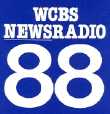 |
THOSE WERE THE DAYS
by Robert Vaughn
|

There was a standoff outside the gates to Columbia University, but amid the shoving and shouting it was easy to see who ultimately would win. University jocks were on one side of a set of massive gates and a huge crowd of people, largely black, was outside and demanding to get in for a Black Power march across the Morningside Heights campus.
My vantage point was a WCBS Radio van and my technician and I were being treated to a rough ride: demonstrators on each side were rocking the van, apparently intent on turning us over. This was part of the spring 1968 demonstrations in which black students occupied Hamilton Hall and held Dean Coleman hostage for seven days while others occupied Low Library and President Grayson Kirk's office, helping themselves to his cognac and cigars.
Groups including Students for a Democratic Society were protesting the ROTC, CIA recruiting on campus, military research, the draft and the Vietnam War in general. The Black Liberation Movement was demanding Columbia drop plans to build a gymnasium in Morningside Park, between the campus and Harlem. Ultimately they won.
The jocks either gave up or were hustled off by police, who feared a larger riot in Harlem. Some big names in the turmoil of the '60s and '70s were on campus that spring: Rap Brown, Stokely Carmichael, Tom Hayden and Mark Rudd, among them.
I had joined the CBS all-news radio station in New York City a year earlier and although I was an anchorman, anchors often were grabbed by producers to cover breaking stories. That's why I waded into a surly crowd from Harlem to get interviews while a Mau Mau leader named Charles 37X Kenyatta used a bullhorn to exhort the crowd to storm the gates. I didn't think until later that circulating in that mob was not the coolest thing I could have been doing on a balmy night.
When I returned to the van, the technician looked a little seasick (or maybe a bit frightened) but the university gates had opened, the crowd staged their march across campus and never did flip our car. Rocking of news mobile units seemed to be a popular tactic among militants of the era: WCBS anchorman/reporter Harvey Hauptman was covering a story in Spanish Harlem when his unit was treated to rocking-and-rolling, but his Spanish speaking tech, Joe Canda, talked them out of a tight spot.
Joe would have come in handy one pre-dawn morning when I was alone and lost in the part of the Bronx known as Fort Apache. In October, 1976, that area was among the poorest and most violent places in the country. I was afraid to stop to ask for directions but soon found the grim scene I was looking for: 25 young people died and as many were injured in a fire in a Puerto Rican social club. They were either burned or trampled in the panic to escape. Outside the blackened building, pretty dancing shoes were lying on the sidewalk, apparently washed out by the fire hoses. Authorities said a patron who was thrown out went back and started the fire, and a principal exit door had been chained shut.
In the Big Apple job I had always wanted, my second decade was mostly spent in the WCBS anchor chair. Earlier, from 1967 into the early '80s, I covered many events, some bland, some downright scary. Anti-war, anti-capitalism people so crowded into Wall Street that some of us helped keep smaller-and-weaker reporters from being trampled; people demanding control of the schools in Brooklyn's Ocean Hill-Brownsville area (more shouting and shoving and someone relieved my technician and me of about $2,000 worth of CBS equipment) ; police horses storming down the sidewalks outside Madison Square Garden while presidential candidate George Wallace held a rally inside. Those animals were BIG, some slipping and sliding with steel shoes pounding the concrete.
I sprinted into the old New Yorker hotel to avoid a charging horse as police tried to control thousands demonstrating for and against Wallace's American Independent Party. The Garden was packed with 20,000 people in the largest political rally in the city since Franklin D. Roosevelt appeared in 1936.
When Joe Colombo was shot on Columbus Circle during a 1971 rally by Colombo's Italian American Civil Rights League, three of us from WCBS, (Irene Cornell, Dave Marash & myself), rushed up to cover the story. Many of the estimated 50,000 people saw Colombo fall and some saw the shooter captured by Colombo's men; someone then shot Colombo's killer in the head. Like Oswald in Dallas, the gunman was silencedä no way to learn why he did it or if someone ordered it.
Some reporters were being pushed around by burly thugs and we didn't know until later that the man who shot the Mafia boss was wearing a press pass, the same kind we were wearing. When Mayor Abe Beame arrived, I tried to follow him into the Circle but found a wise guy's fist pressed against my chest. Beame, who knew me from past interviews, either didn't see that or chose, as I did, not to protest. To paraphrase some famous dead guy, valor is not a virtue "when it is pushed to excess. "
And, after all, it was just in a day's work, '70s style.
return to main WCBS Appreciation Site page

